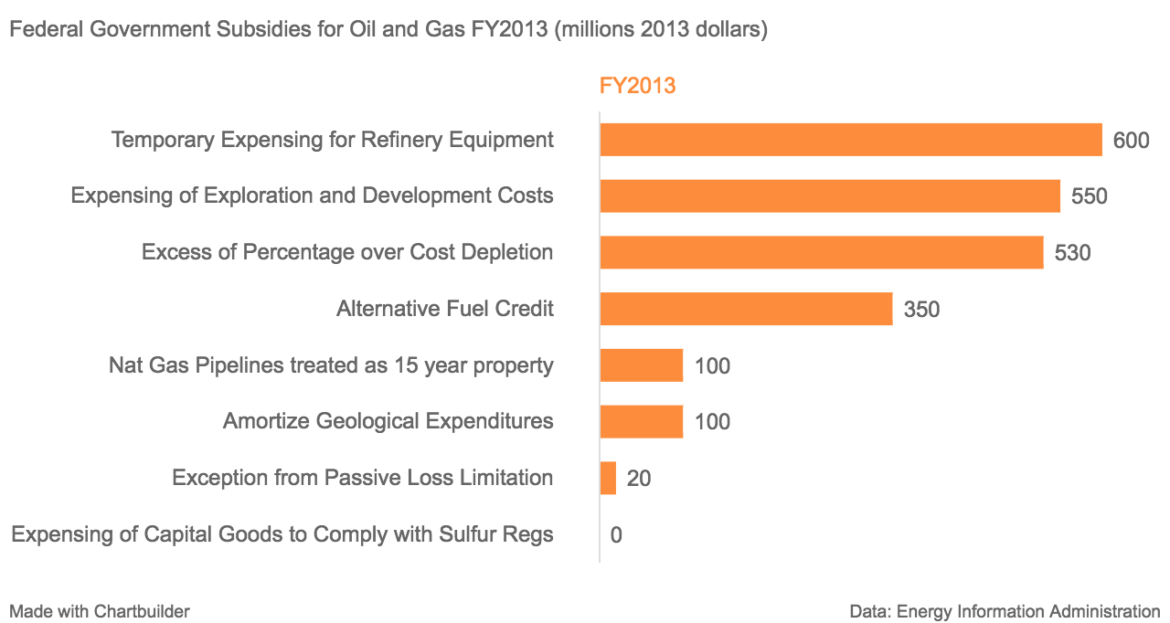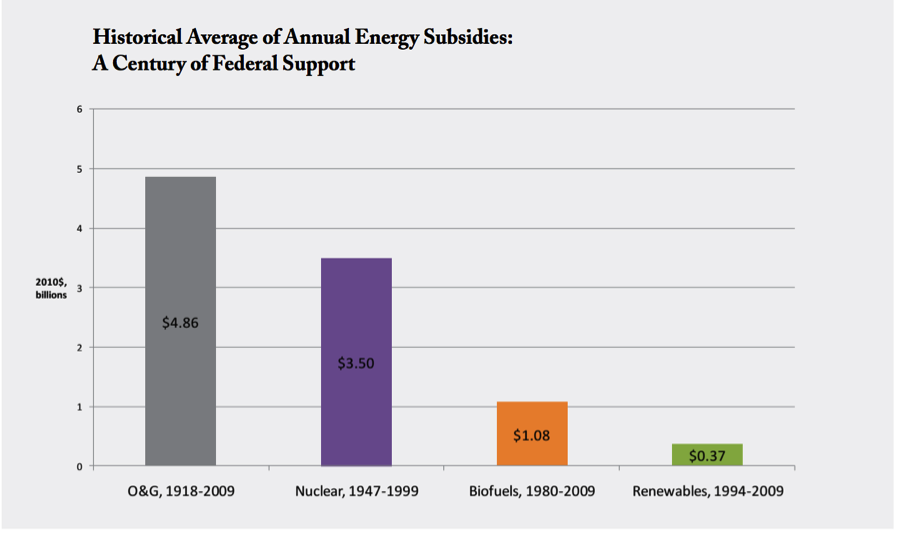What kind of subsidies does natural gas get from the government?
Simple question, right?
But the response is complicated.
This question was submitted by one of our audience members, and it’s one the Inside Energy team has wanted to tackle since our first day on the job. So we were thrilled when you, our audience, chose it in our latest voting round.
What’s a subsidy anyway?
Let’s start with defining terms. Merriam-Webster defines subsidy as: “money that is paid usually by a government to keep the price of a product or service low or to help a business or organization to continue to function.”
Governments all across the world subsidize energy, including renewable and fossil fuel sources. In the developing world and in primary oil producing nations, these subsidies fit the definition above: direct government aid to keep prices low for consumers.
In the U.S. and other industrialized nations, subsidies are mostly in the form of tax incentives and tax breaks which give the industry the opportunity to cut production and development costs. A 2015 report from Oil Change International claims subsidies in G20 nations for fossil fuel production amounts to $444 billion annually.
It is all about POLITICS!
It is impossible to talk about energy subsidies without acknowledging the politics surrounding the issue. Hillary Clinton has vowed to end subsidies for fossil fuels. The Obama Administration has tried to kill tax breaks for oil and gas companies in each and every budget. Congress has never gone along.
In 2009, the G20 nations pledged to phase out fossil fuel subsidies – a promise that has largely gone unfulfilled.
The American Petroleum Institute, the lobbying arm of the oil and gas industry, argues that its industries are not uniquely subsidized, in fact many of the tax provisions labeled as “subsidies for oil and gas” also apply to other industries.
Finally: Your Question
What kind of subsidies does the government support natural gas?
The official figures come from the Energy Information Administration, an arm of the Department of Energy. We’re going to look at oil and gas together, because most wells produce both oil and gas and most subsidies apply to both oil and gas producers.
According to a 2014 report by the EIA for Congress, there are three main subsidies for oil and gas: research and development, direct funding, and tax expenditures. In 2013 the EIA calculates that the oil and gas industry was subsidized to the tune $2.3 billion. When you break it down, its clear that the overwhelming majority of federal subsidies are in the form of tax breaks or incentives:

The EIA counts eight different tax provisions that benefit the oil and gas industry. The two most important ones are permanent parts of the tax code and date back to the early years of the 20th century!

Those two most important tax breaks are really, really old.
- Happy 100th birthday to the “expensing of intangible drilling costs (IDCs) and dry hole costs” exemption! (Born in 1916.) This tax break allows companies to expense the entire costs related to site improvement and drilling of a well in the year that the costs are incurred.
- The 90 year old “Percentage over cost depletion deferral” (born in 1926) allows drilling companies to deduct a fixed percentage – 15 percent – of the revenue from each drill site, with some limitations. This exemption is also used by coal, timber and other mineral industries.
OK, $2.34 Billion. Is that all?
The EIA is relatively conservative when counting up the subsidies for fossil fuels, including oil and gas. In their own report they enumerate all the different subsidies that could be counted, but weren’t, such as:
- the domestic manufacturing deduction, which allows oil and gas producers to deduct six percent of domestic production costs. (The same provision applies to many other industries as well, including architects and film producers.)
- subsidized credit for energy infrastructure projects
- foreign tax credits
- energy related trust funds tied to mine reclamation, leaking underground storage tanks or oil spills.
And there are other more hidden subsidies that could count, like:
- financial vehicles like Master Limited Partnerships, or MLPs, to finance the midstream (distribution) sector of oil and gas. Some estimate revenue losses to the U.S. Treasury (i.e. tax breaks) via MLPs at $1.2 billion/year through 2018.
- historical subsidies such as the conversion of oil pipelines to natural gas after World War 2, or government funding for research into the combustion turbine which were eventually converted by utility managers into natural gas generating units.
Adding it all up, more inclusive estimates from put the overall subsidies for fossil fuels (including coal) at between $4 billion, according to a recent Council on Foreign Relations report, and $4.7 billion annually, according to the U.S. Treasury.
For some perspective, total U.S. tax revenue in 2015 was $3.2 trillion, which means that oil and gas subsidies take only about 0.15 percent out of that total. But it’s nearly enough money to build an entire aircraft carrier!
And then came renewables…
Subsidies for renewables like wind and solar have soared in recent years. In 2013 the EIA estimated total renewable subsidies at $15 billion annually, (compared to $2.3 billion for oil and gas). Total subsidies for solar in 2013 were $5.3 billion and wind $5.9 billion.

Still, seen over the long course of energy support from the federal government, renewable subsidies pale in comparison to those given to fossil fuels. This table, from the report “What Would Jefferson Do?” shows the cumulative amount of subsidies each industry has received, at least through 2010:

DBL Investors
From “What Would Jefferson Do?” by DBL Investors, 2011.
The report looked at subsidies for emerging energy industries in their first 15 years of life, and found that the federal commitment to oil and gas was five times greater than the federal commitment to renewables. For the nuclear industry, the commitment was 10 times greater.
In terms of subsidies, this is just the beginning of the story. For example, we’ve only looked at federal government subsidies here, but some states also provide subsidies for energy development. What else do you wonder about subsides, or energy in general? Share your question below, and it could become our next story.








